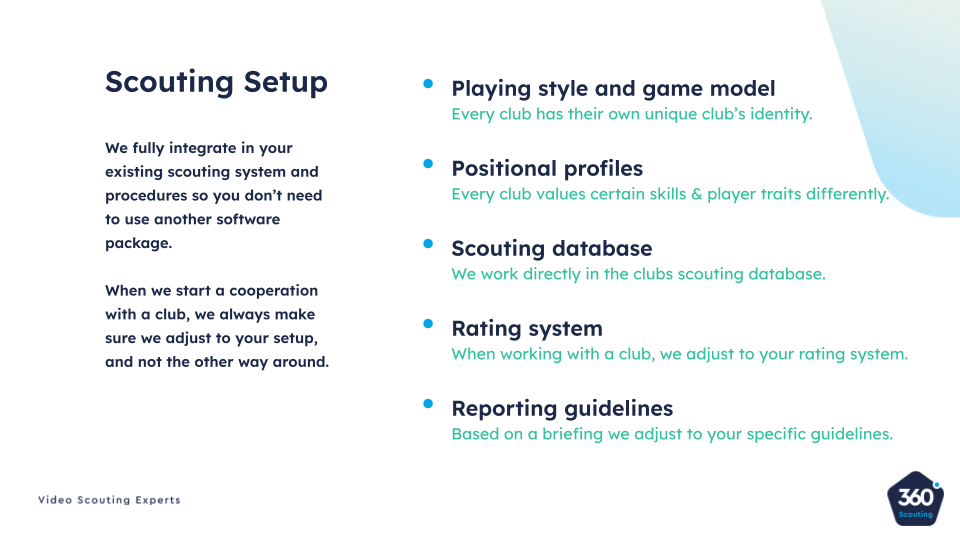If there’s one thing we’ve learned that clubs hate, it is having to implement many different platforms and applications into their organization. Sooner or later, information won’t align, and that creates problems. Therefore, we always adjust to a club’s scouting setup once we set up a cooperation. In this article, we explain what that entails.
When we start a cooperation with a club, we always make sure we adjust to them, and not the other way around. In other words, we ask questions about the club’s scouting processes and our scouts show flexibility in adjusting to them.

It mainly entails five different aspects:
#1: Playing style and game model
To some extent, every club has its own unique club’s identity. Sometimes, the playing style and game model are described step-by-step in fancy documents and presentations. For other clubs, it’s in the heads of the people at the club.
One way or another, it is very important information for our video scouts to take into account. Evaluating a player for a patient possession-based team requires a different skill set than for a high-intensity and direct team with a lot of emphases on pressing and counterpressing.
#2: Positional profiles
What most clubs look for in a player, is the complete package. A striker should score many goals, have a big contribution in the build-up, and press with a high intensity for 90 minutes. At the same time, every club values certain skills and player traits differently.
In scouting, this can make a huge difference. If you value the height of a central defender more or less compared to other clubs, that’s very relevant information. The same holds for the defensive quality of a winger or the passing skills of a holding midfielder.
#3: Scouting database
Every club uses a scouting database to enter player reports. By doing so, information is stored and can be easily used to check ratings read reports, and assign follow-up actions. Common scouting databases are ISF Scout7, SAP, SoccerLAB, ProSoccerData, Scoutastic, and SouScout.
When we start a cooperation with a club, we always suggest that the club creates accounts in their scouting database for our scouts. The club provides the scouts with permission to only see their own player reports.
#4: Rating system
Clubs use many different rating systems, such as A/B/C/D, 5/6/7/8/9 and green/orange/red. Such a rating system comes with an explanation for every separate rating. Usually, clubs both evaluate a player’s match performance or current level as well as their potential.
When working with a club, we adjust to that rating system. By receiving a briefing from the club, our scouts know what every rating means and how they should use it effectively.
#5: Reporting guidelines
Some clubs use very specific guidelines for player reports. Examples are physical-defending-attacking-transition or technical-tactical-physical-mental. Other clubs leave way more flexibility for the scouts to decide what they write about a player.
When we start working for a club, our scouts always receive a briefing from the club – usually the head of scouting – about what is expected of them in terms of writing player reports.
Interested? Let’s talk
We help football clubs to make better recruitment decisions. To do that we use advanced video scouting to evaluate players in great detail. With our team of elite video scouts, we create additional manpower fully integrated into your existing scouting processes. This enables you to find more suitable players, act faster, save money and make better informed decisions.
Want to learn more? Contact us and schedule a meeting!

